Prepare to "Fall Back"
Daylight savings time is coming up on Sunday November 5th and if you’re a mom, you’re probably starting to panic a little bit! I can relate for sure, but I’m here to tell you not to panic. I’ve got you covered on how to help your child “fall back”.
There’s nothing I loved more than gaining an extra hour of sleep, BEFORE I had my girls. As a mom, an extra hour of sleep sounds like a fantasy. Maybe you finally got your child sleeping great, they’re going to bed easily, and they have a good sleep schedule. Or, maybe your child is already waking up between 5 and 6 AM and you’re worried about a 4 AM wake up call.
Even though it’s just an hour, it really does have an effect on all of us, especially our little ones. They tend to have a set bedtime every night and wake up at the same time every morning. But since we are gaining an hour, the transition is more about how you can keep your child’s schedule on track and not so much about having sleep debt from losing an hour. I’m going to share with you how to gradually make this adjustment to your little one’s sleep schedule.
Should You Start This Change Early?
If you’re thinking of getting ahead of the game and making some changes now and that would work better for you then you can absolutely start early. Since daylight savings begins Sunday, November 5th, try making the change earlier, starting today, which coincides with Halloween when you may be keeping your little one up later due to the holiday.
You can start to modify their bedtime by 15 minutes every couple of days. For example, if your child goes to bed at 7:00 pm push it back to 7:15pm. Then, after 3 days push it back another 15 minutes, (7:30 pm) then again, a few days later until you’re at an 8:00 pm bedtime by Sunday night. This is just in time for daylight savings, because an 8:00 pm bedtime will really be 7:00 pm now with the time change.
Nap schedules can be approached the same way by gradually pushing them back at the same interval. Again, any type of change to your child’s schedule will take about a week so don’t stress if your child is taking some time to adjust.
"Split the Difference"
We always wait until Sunday morning and then start adjusting the clocks from there. We find it less stressful this way. Now of course if you need your little one on a set schedule for work or school reasons then you may need to make the change sooner and faster. It will still take them time to adjust, but you can “split the difference.”
By “split the difference” I mean, splitting the hour we are losing in half. Adjust your child’s schedule by 30 minutes for a few days, then another 30 minutes until you’re back on track. Sound confusing? Keep reading for more specifics!
Babies Not on Set Schedules
If your baby is under 9 months or taking 3 or more naps, chances are these naps vary every day. That makes this time change super simple for you. Continue to strictly follow awake windows for your little one. That’s it, just keep following those awake windows! If your little one wakes up at 7:00 am, which is now 6:00 am, start the awake window from the new time.
But, you could be struggling with early morning wakings, which can be tough to navigate. If you like your normal schedule, try offering a catnap before bed so bedtime isn’t super early. Put baby to bed close to “normal” time. This is a fine balance, you want to avoid overtiredness at all costs, so earlier bedtime is the better option is naps weren’t great. Then you can gradually shift bedtime back 15 minutes every few nights.
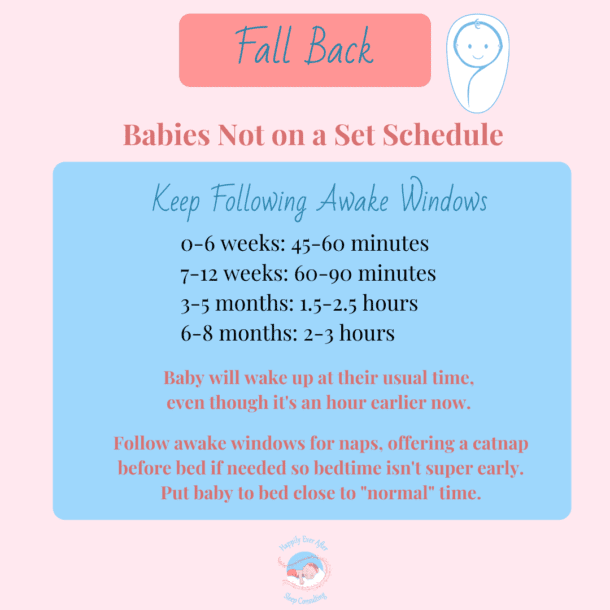
2 Nap Schedules
If your baby or toddler is on 2 naps then you want to gradually shift their schedule to get back on track following the time change. Usually after the 6-7 month mark, bedtime has become more predictable and your little one is probably going to bed around the same time each night. You want to move bedtime later by 15 minutes every 2 nights. For example, if bedtime is normally 7:00pm (now 6:00pm) move bedtime to 6:15pm nights 1 and 2. Nights 3 and 4, 6:30pm, and so on. On night 7, you should be back to 7:00pm.
If you’re looking to make this change faster you can make the shift in 30 minute intervals versus 15 minutes. Some babies handle more awake time better than others. If this sounds confusing or you need an example, take a look at both graphics below. It’s easier to visualize it will the example.
Make sure you are starting your child’s bedtime routine early enough so that they are in bed by the new time, not starting the routine at the new time. Just know that it will take about a week for your child’s body to get used to this. It takes your body clock roughly one week to adjust any kind of change in sleeping habits.
But what about naps? Same methodology! Put baby down 15 minutes later for each nap until they are back to their normal schedule which should align with bedtime. Let them sleep in the morning to stay on track with your ideal wake time. If you’re seeing early morning wakings try to keep your child in their crib as close as you can to their normal wake up time.
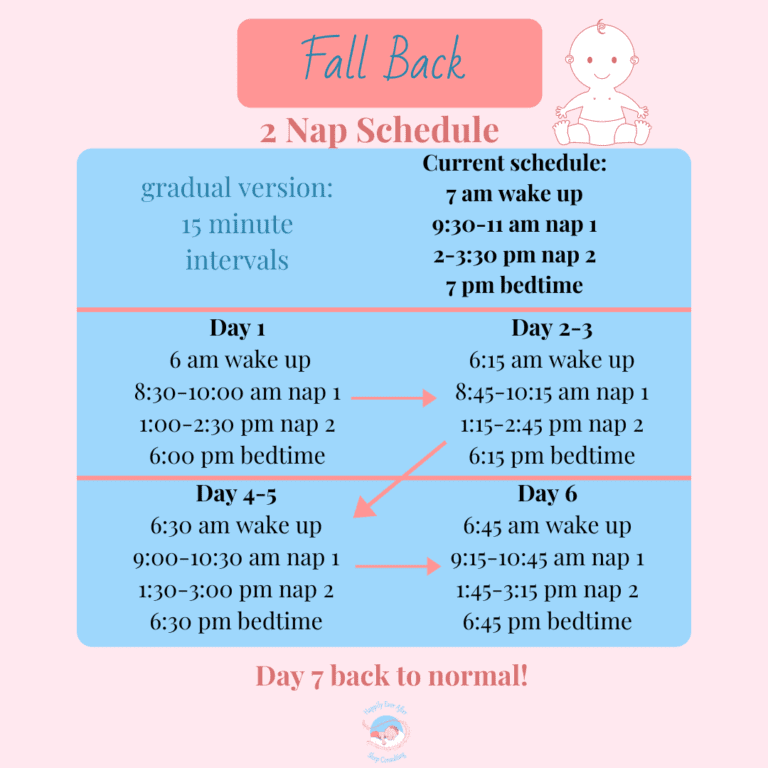
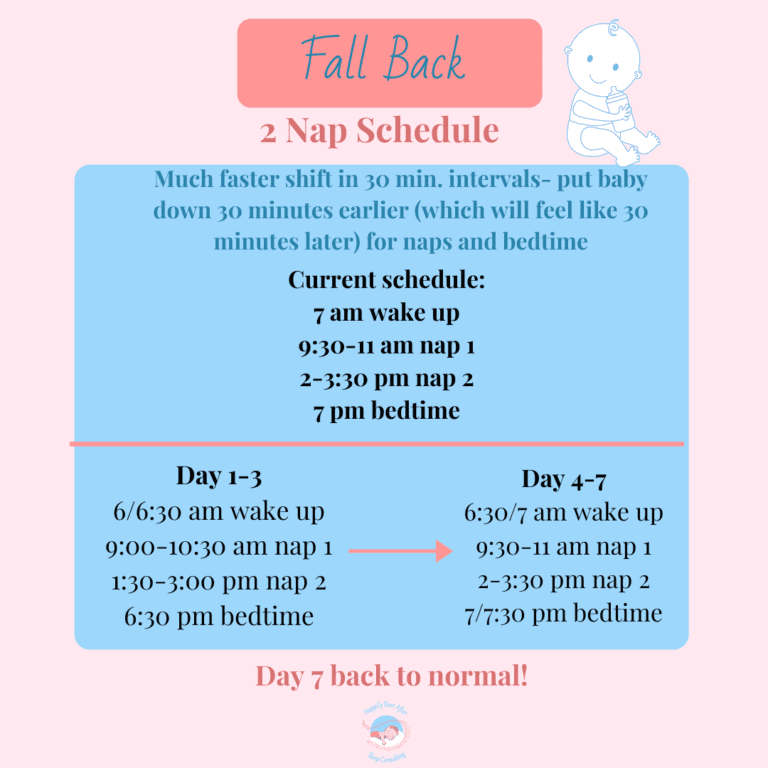
1 Nap Schedules
If your toddler takes 1 nap, this transition should be relatively easy for them. They will be able to make this transition faster because they can handle more awake time during the day. I recommend shifting bedtime back by 30 minutes for 2-3 days. So, if normal bedtime is 7:00 pm (6:00 pm now), you would put your toddler down at 6:30 pm. Do this for 2-3 nights after the time change and then on the 4th or 5th night, put your child to bed at 7:00 pm. Then your child is back to their normal schedule.
Naps can be approached the same way. If naptime is 12-2 pm, put your child down at 11:30 am (which will feel like 12:30 pm). Stay there for 2 or 3 days then shift back to the normal time which will align with bedtime. Don’t worry if your toddler takes some time to fall asleep or doesn’t sleep as long. Even though they adapt faster it can still take time for their body clock to adjust.
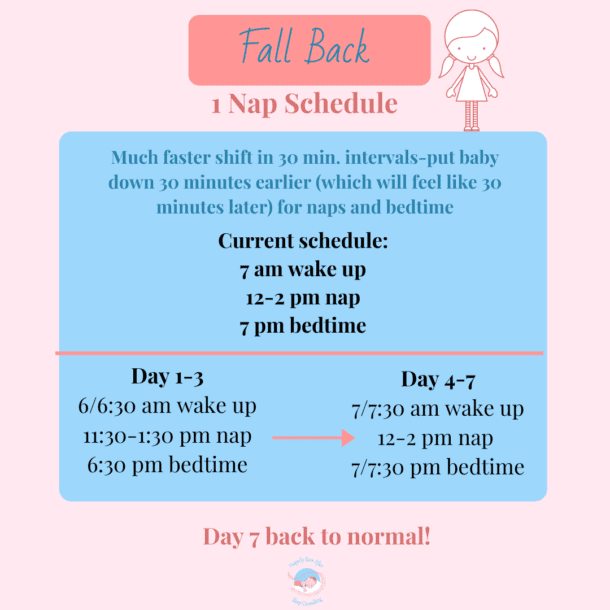
No Nap Schedule
If your child does not nap, just work on adjusting bedtime. If bedtime is normally 7:00 pm (6:00 pm now), you would put your child to bed at 6:30 pm (this will feel like 7:30 pm) on Sunday night, the first night of the time change. For 2-3 nights, continue to put your child to bed 30 minutes earlier than normal, then on the 3rd or 4th night put your child to bed at the normal time.
In order to help your toddler with early morning wakings, I recommend using a toddler clock, like the Hatch. You can set the “wake up light” gradually to align with your strategy. Start with 30 minutes for 3 nights, then push it forward another 30 minutes to have it light up at the appropriate time. With this method your toddler will stay in bed until the appropriate time even if they’re already awake. With time their body clock will adjust to the new schedule.
Even though your child isn’t napping offering quiet time will give them some independent play time and mom or dad a much needed break. Using a toddler clock is the perfect approach to let them know when quiet time is up so they are staying in their room for at least 45 minutes to an hour. You may need to start with less time if this is new to them. Again, the Hatch is my go to toddler clock, but you can view my other favorites here.
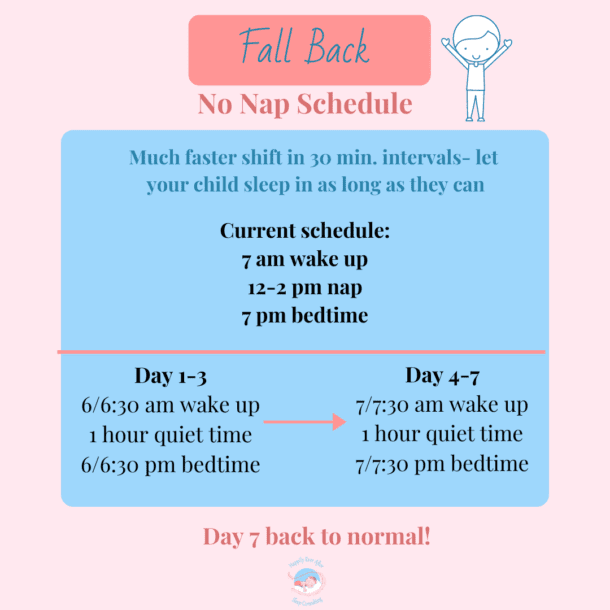
Other Helpful Tips
Children and adults sleep best in a dark room. Darkness helps your child’s melatonin kick in which helps them fall asleep faster at bedtime. If your child’s room does not have black out blinds, I recommend you get some to help keep your child’s room dark. There are a few different options for blackout solutions depending on if you want something you can take down and put back up or something more permanent. You want to make sure there’s no light coming in from around the edges of the window.
Exposure to sunlight throughout the day will help set your child’s body clock and adjust to the new time. Vitamin D boosts melatonin levels naturally without needing to take any supplements.
For those of you reading this and thinking, this doesn’t sound too complicated, but my child is struggling with sleep now which will make Daylight Savings more challenging. I hear you and I can help. The time change is a big adjustment, especially if your child is not an independent sleeper. I offer customized sleep plans with my support to help you get your child sleeping independently for bedtime and naps. Schedule a FREE sleep evaluation call with me today so we can talk about some solutions for you and your family.

